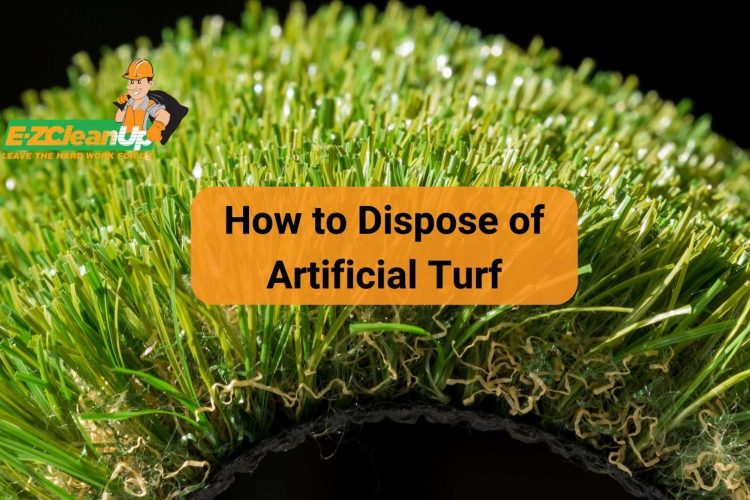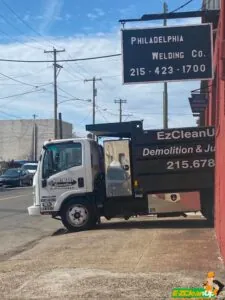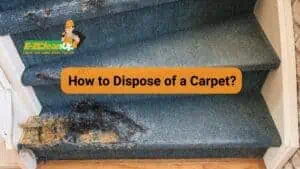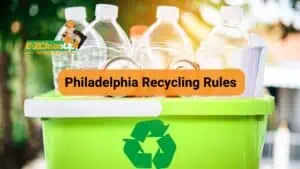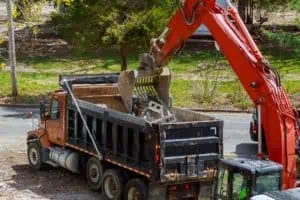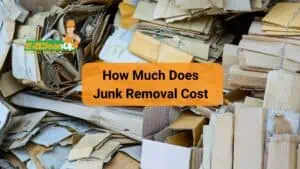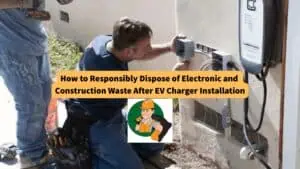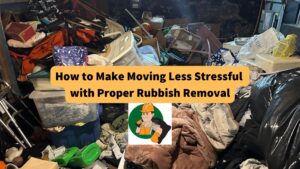To responsibly dispose of artificial turf, consider donating to local sports clubs or recycling through specialized facilities. Explore innovative upcycling for community projects.
Learn more about the sustainable options on how to dispose of artificial turf in our guide below.
Options for Disposing of Artificial Turf
Given that artificial turf is composed of complex polymers and infill materials, its disposal poses significant environmental challenges. However, disposing of it responsibly is a challenge that requires attention.
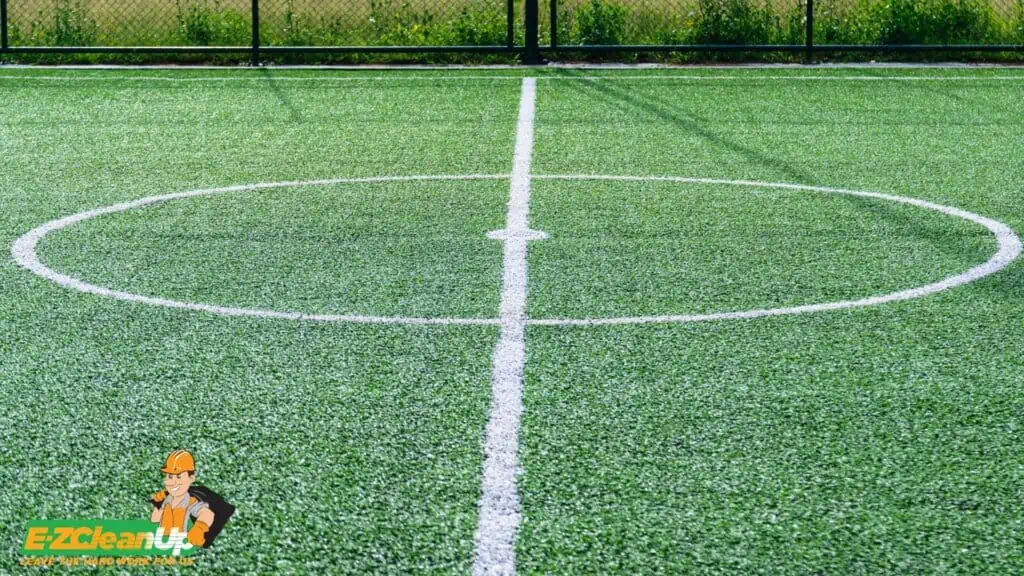
Donation Possibilities
Donating used artificial turf can significantly impact local communities by providing resources that might otherwise be unaffordable or inaccessible.
Local Sports Clubs and Community Centers
Sports clubs and community centers often operate on limited budgets, which makes donated artificial turf a highly valuable asset. By repurposing turf in these settings, you not only support local sports and recreational activities but also advocate for sustainable resource use.
Before donation, ensure the turf is in suitable condition for further use. Make sure that you coordinate with the recipient to facilitate the transfer.
Schools and Recreational Areas
Schools can use the turf for playgrounds or sports fields. It will help enhance the safety and appearance of outdoor spaces. Recreational areas, including parks and community gardens, can also benefit from the durable, low-maintenance surface artificial turf provides.
When considering these options, it’s important to communicate with administrators or local authorities to understand their needs and the feasibility of turf installation.
Recycling Artificial Turf
Despite the technical and economic challenges associated with recycling complex composite materials like artificial turf, advancements in recycling technologies have opened new doors for sustainable disposal.
It allows you to reduce landfill waste and explore alternatives that highlight the benefits of bermuda grass as a natural, eco-friendly ground cover. These innovations are driving a shift toward more sustainable landscaping practices.
Recycling Facilities That Accept Artificial Turf
Recognizing the need for sustainable disposal options, several recycling facilities worldwide have begun accepting artificial turf. These specialized centers have developed processes to dismantle and repurpose the various components of artificial turf, including nylon, polyethylene, and polypropylene.
Before committing to recycling, it’s essential to identify facilities capable of processing artificial turf, as not all recycling centers have the necessary equipment or capabilities. Research and direct communication with potential recyclers can help ensure that the turf is handled responsibly and efficiently.
Process of Recycling Artificial Turf Materials
The recycling process for artificial turf involves multiple steps, each designed to recover and repurpose the materials efficiently:
- Collection and Preparation: The first step may include removing any debris, cutting the turf into manageable pieces, and transporting it to the recycling facility.
- Separation of Components: Upon arrival at the recycling center, the turf undergoes a separation process to distinguish between the synthetic fibers, backing material, and infill. This separation is crucial for the recycling of each material type.
- Material Processing: Once separated, the materials are processed accordingly. Plastics like nylon, polyethylene, and polypropylene can be melted down and reformed into pellets, which serve as raw materials for new products. Infill materials, depending on their composition, may also be repurposed or recycled.
- Transformation into New Products: The final step involves transforming the processed materials into new products. This could range from construction materials, such as irrigation piping, planks, and posts, to other innovative uses that contribute to circular economy principles.
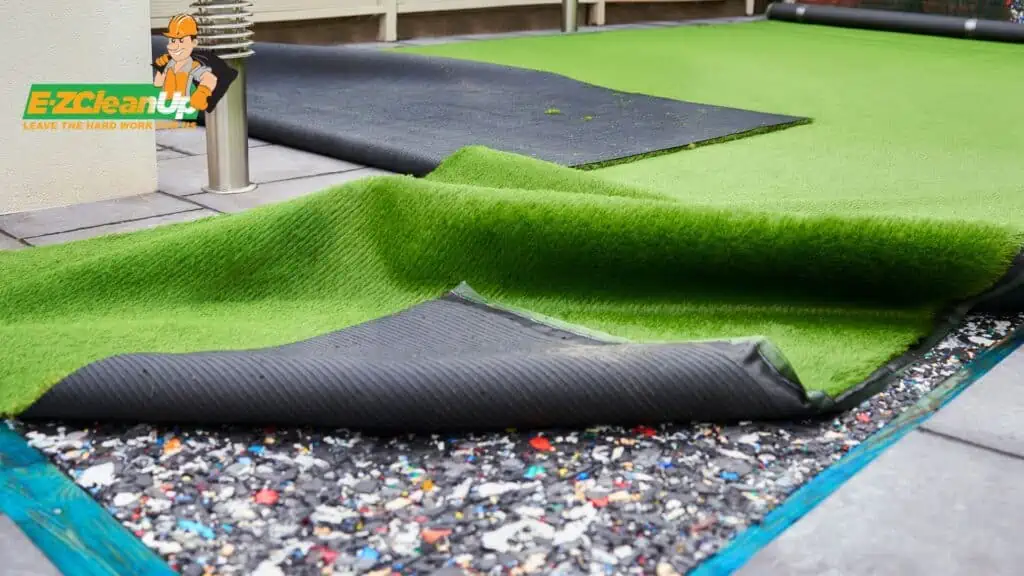
Landfill Considerations
Disposing of artificial turf in landfills should be a last resort, given the environmental implications and the potential for recycling.
When Landfill is the Only Option
There are circumstances where sending artificial turf to a landfill becomes the only feasible solution:
- Limited Recycling Options: In areas where recycling facilities capable of processing artificial turf are not available, landfill disposal may be the only alternative.
- Degraded Condition: Turf that is extensively worn or contaminated and cannot be repurposed or recycled must be disposed of, and often the landfill is the only option.
- Economic Constraints: The cost associated with recycling artificial turf can be prohibitive, leading some to opt for landfill disposal as a more economically viable option.
Environmental Impact of Artificial Turf in Landfills
The disposal of artificial turf in landfills presents several environmental challenges:
- Long-term Persistence: The materials in artificial turf, such as nylon, polyethylene, and polypropylene, are slow to degrade and can persist in landfills for centuries. They can contribute to long-term waste accumulation.
- Potential for Leachate Formation: As artificial turf breaks down, it can release chemicals into the landfill leachate, potentially contaminating groundwater and surrounding ecosystems.
- Space Consumption: Artificial turf takes up valuable space in landfills, which are already under pressure from increasing amounts of waste. This not only reduces the landfill’s lifespan but also necessitates the development of additional landfill sites, further impacting the environment.
Preparing Artificial Turf for Disposal or Recycling
The proper disposal or recycling of artificial turf requires preparation to ensure that the process is as efficient and environmentally friendly as possible.
Cleaning and Dismantling Artificial Turf
It’s important to clean the turf thoroughly to remove dirt, debris, and any other contaminants. This step ensures that the materials are ready for recycling and reduces the risk of contaminating recycling processes.
Carefully dismantle the turf by separating the different components. This may involve cutting the turf into sections, removing the infill, and detaching the backing material. Proper dismantling facilitates the recycling process and helps in the efficient separation of materials.
Sorting Materials for Recycling
After dismantling, the next step is to sort the materials:
- Identify Recyclable Components: Artificial turf is made of various materials, such as nylon, polyethylene, and polypropylene, which are recyclable. Identifying these components is crucial for successful recycling.
- Separation Process: It’s recommended to separate the synthetic fibers from the backing and infill materials. Although challenging, this separation is necessary for recycling centers to process the materials properly.
- Consultation with Recycling Centers: Before proceeding, check with local recycling centers to confirm they accept artificial turf materials. This step ensures that the effort to recycle does not go to waste and that the materials are handled responsibly.
Innovative Reuse and Upcycling Ideas for Artificial Turf
Artificial turf, once deemed fit for replacement, doesn’t need to end its utility in a landfill. Innovative reuse and upcycling of artificial turf can breathe new life into this durable material.
Home and Garden Projects
Creating Green Spaces on Balconies or Patios
Transforming balconies or patios into lush, green spaces is an excellent way to reuse artificial turf. Offcuts of turf can be laid out to cover unsightly flooring, offering a soft, green touch underfoot.
This enhances the aesthetic appeal of outdoor living areas while providing a low-maintenance solution for those seeking a touch of nature without the need for regular watering or mowing.
DIY Outdoor Rugs or Mats
These custom rugs can define outdoor seating areas, provide a comfortable surface for children’s play areas, or serve as a welcoming mat that withstands the elements. Cutting the turf to fit specific dimensions and shapes allows for personalization and creativity, which makes each piece unique to your home’s design.

Community and Commercial Upcycling Projects
Playground Surfaces
Repurposing artificial turf for playground surfaces offers a durable, safe, and visually appealing solution. Used artificial turf can provide a cushioned ground cover that reduces the risk of injuries, which makes it an excellent choice for areas where children play.
Pet Training Areas
Its durability and ease of maintenance make it suitable for both indoor and outdoor pet facilities. Upcycling artificial turf for pet training areas offers a hygienic, low-maintenance surface that can withstand the rigors of training activities. It also provides a practical and eco-friendly solution for pet owners and trainers alike.
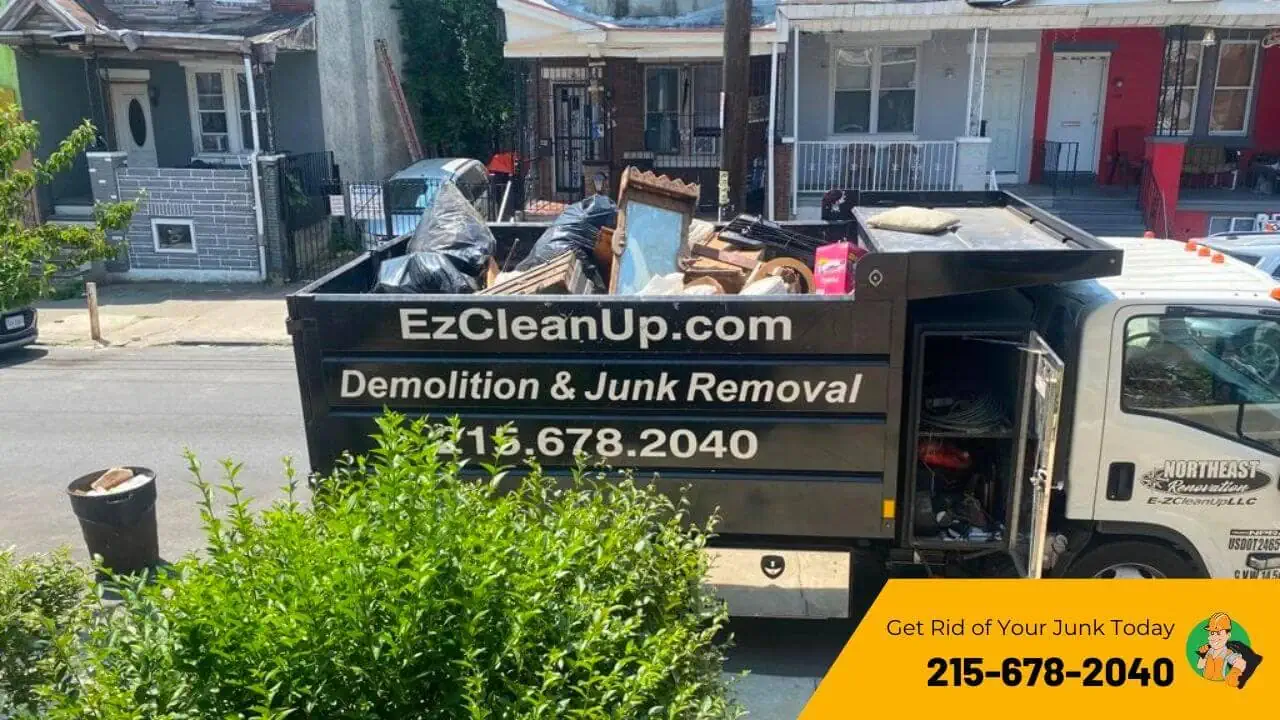
Professional Services for Artificial Turf Disposal
Selecting the right professional service for disposing of artificial turf is crucial for ensuring the material is handled responsibly and in an environmentally friendly manner. Whether dealing with small sections of turf or managing the disposal of large quantities, professional services can provide efficient and sustainable solutions.
Hiring a Junk Removal Company
For those looking to dispose of smaller amounts of artificial turf, hiring a junk removal company is a practical solution. We at EZ CleanUp can get the job done. We specialize in removing various types of waste and can ensure that your artificial turf is disposed of responsibly. Our company is committed to sustainable practices, including recycling or repurposing materials whenever possible.
Renting a Dumpster for Large Quantities of Turf
For projects that involve large quantities of artificial turf, renting a dumpster can be an effective way to manage disposal. This option allows for the collection of turf over time, providing a centralized place for disposal before the dumpster is hauled away. This is another service that we offer at EZ CleanUp. You can check out our price listing page to see how much the service will cost.
Before renting a dumpster, it’s important to dismantle and sort the turf as required to ensure that it’s ready for proper disposal or recycling. As with hiring a junk removal company, partnering with a dumpster rental service that prioritizes eco-friendly disposal methods can help reduce the environmental footprint of your turf disposal project.
Legal and Safety Considerations in Turf Disposal
Understanding the regulations governing turf disposal and adhering to safety guidelines during handling and transportation are crucial steps in responsibly managing artificial turf waste.
Regulations on Artificial Turf Disposal
Although there are no specific state or federal regulations for the disposal of artificial turf, local guidelines and environmental policies may apply. Project owners are responsible for ensuring that artificial turf systems are disposed of in an environmentally responsible manner.
This might involve seeking out recycling opportunities, repurposing the material, or ensuring proper landfill disposal. Awareness and compliance with local waste management policies can prevent environmental harm and potential legal issues related to improper disposal.
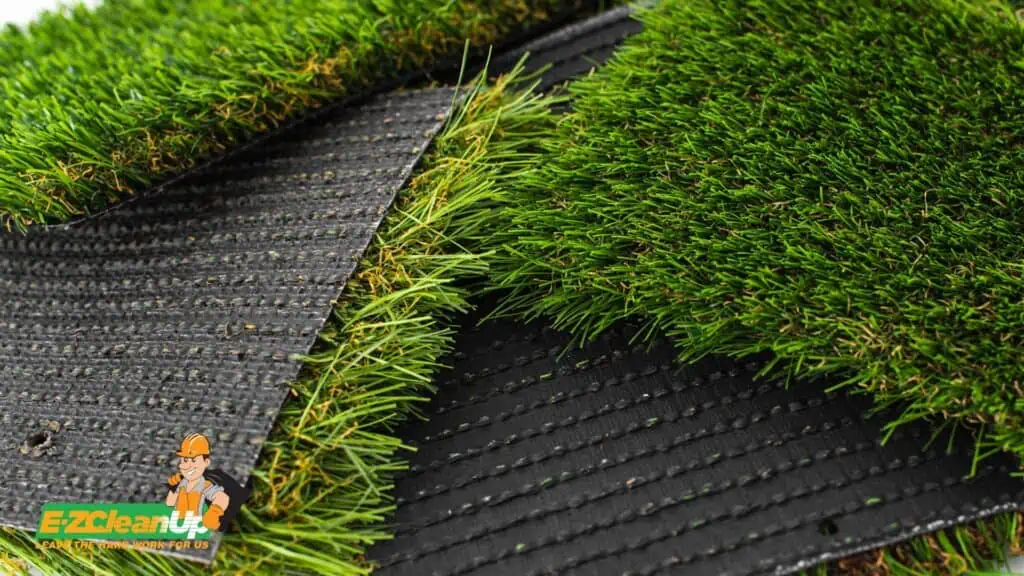
Handling and Transportation Safety Tips
Safety during the handling and transportation of artificial turf is crucial to preventing injuries and accidents. The material’s weight and bulkiness require careful planning and execution when moving it:
- Proper Lifting Techniques: Utilize safe lifting practices to avoid back strain or injury. This includes bending at the knees and lifting with the legs, not the back, and asking for assistance with heavier sections.
- Equipment Use: Employ suitable equipment, such as dollies or hand trucks, for moving large pieces of turf, especially over longer distances.
- Secure Transportation: Ensure that artificial turf is securely fastened during transport to prevent it from shifting or falling, which could cause road hazards or damage.
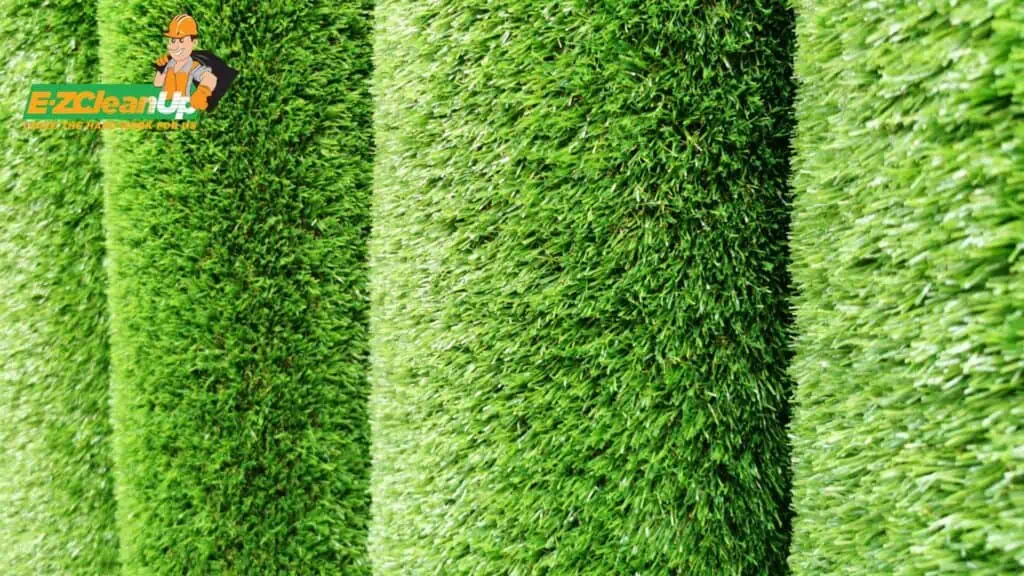
FAQ
Can I Put Artificial Turf in My Recycling Bin at Home?
No, artificial turf should not be placed in your home recycling bin. The complex composition of artificial turf, including various types of plastics and infill materials, requires specialized recycling processes. These are beyond the capabilities of standard municipal recycling programs. For proper disposal or recycling, you’ll need to explore specialized facilities or services.
Are There Any Eco-Friendly Alternatives to Artificial Turf?
Yes, there are eco-friendly alternatives to artificial turf that offer environmental benefits without disposal concerns. Options include native landscaping that requires minimal water and maintenance, organic grass varieties suited to your local climate, or ground cover plants that provide greenery while supporting local ecosystems. Each alternative has its own unique set of benefits and considerations.
Can Artificial Turf Be Composted?
No, artificial turf cannot be composted due to its synthetic materials, which do not break down in a composting process. Artificial turf is made from plastics and other non-organic materials that require specific recycling or disposal methods to avoid environmental harm.
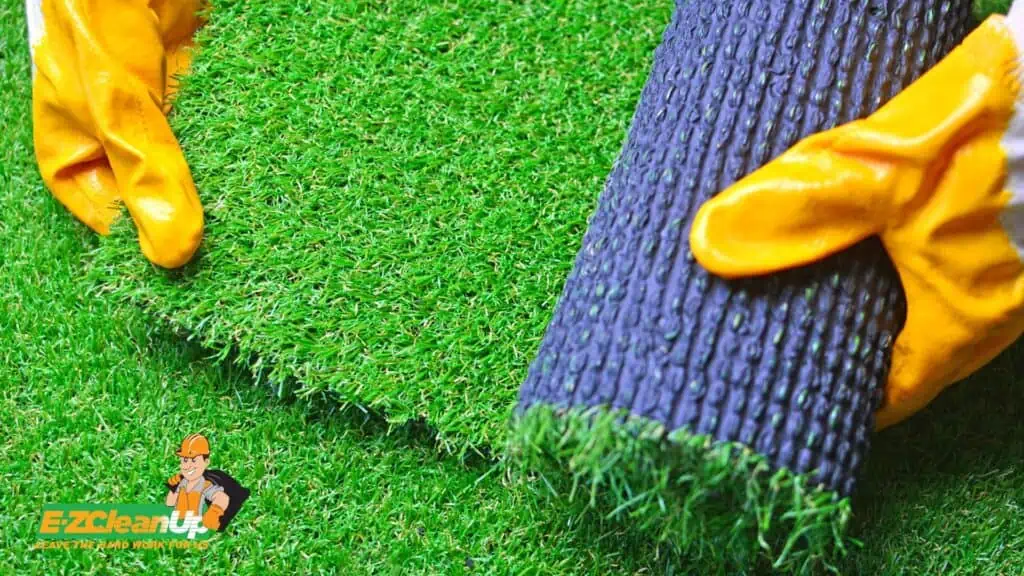
Turning Over a New Leaf with Artificial Turf
Let’s face it, disposing of artificial turf can be as tricky as a well-guarded goalpost. Finding eco-friendly ways to dispose of artificial turf isn’t just about clearing space; it’s about making space for a healthier planet.
Struggling with turf disposal? EZ CleanUp is here to assist. Whether it’s a small patch or an entire field, we’ve got the expertise and equipment to responsibly tackle the challenge. With services ranging from junk removal to dumpster rentals, we ensure your artificial turf finds a new lease on life, away from the sidelines of a landfill.
Reach out to us at EZ CleanUp, and let’s team up for the environment.

